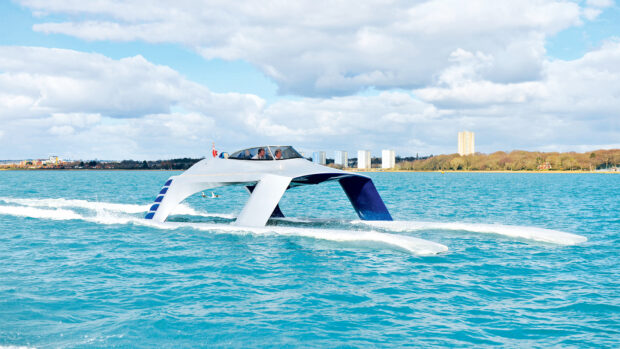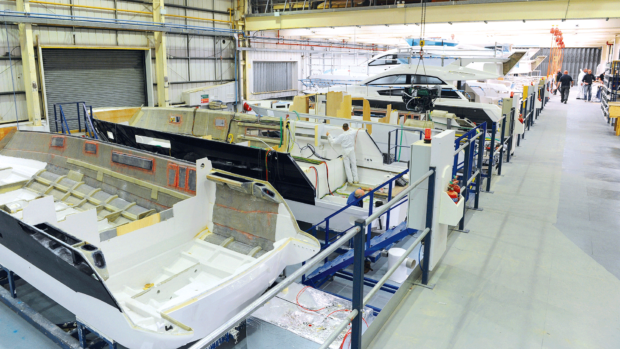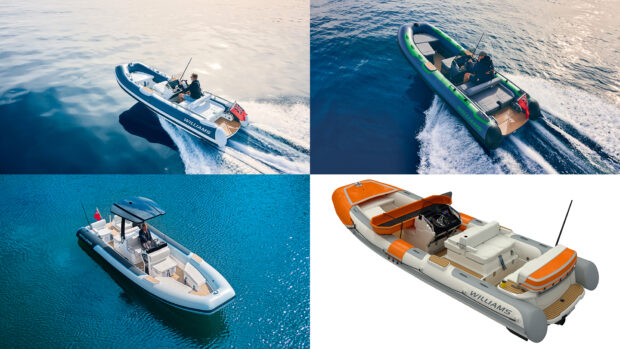The new Humphree Lightning auto trim and stabiliser is claimed to be quicker and smarter than ever. Hugo Andreae investigates…
Humphree may have invented the original interceptor trim tab and the first active trim stabilisation system, but with competitors like Zipwake and Seakeeper now offering similar alternatives, the Swedish manufacturer needed to move the game on.
The new Humphree Lightning series of automatic interceptors does exactly that. Aimed at the market for 20-45ft boats with top speeds of up to 60 knots, it is said to offer better stabilisation under way, as well as improved automatic trim, pitch and cornering control, plus a number of other new features.
The most visible of these is a row of underwater lights built into the interceptor blade’s housing. The 25W LEDs are moulded in as standard during the manufacturing process and are fully adjustable for colour, although Humphree charges an extra €870 to have them enabled.
By combining both trim and underwater lighting functions into a single integrated unit, it saves space on the increasingly busy transoms and dashboards of outboard-powered craft, and avoids having to drill two sets of holes for cabling runs.
This fits in very neatly with another of Lightning’s key new benefits – easy installation. Because the brushless motor for the interceptor blades is now built into the external housing, rather than being in a separate drive unit mounted on the inside of the transom with a drive shaft connecting the two, the only through-transom fitting is for the slender watertight cable supplying power and relaying signals to and from the control unit.
All the installer has to do is screw the mounting bracket onto the transom, drill a small hole for the cable fitting and bolt the Humphree Lightning unit onto the back of it. This is sealed in the factory to ensure it remains watertight, with any software upgrades made over the air via Wi-Fi and Bluetooth.
Article continues below…

Keeping things on the level with Humphree stabilisers
Humphree takes the zero-speed fins story a stage further with its new integrated trim and stabiliser system, writes Dave Marsh

Induced drag and its effect on fuel efficiency explained
Our technical expert Dave Marsh explains how induced drag can affect the fuel efficiency of your boat
Customisable blades
Another first for Humphree is the option of a chine-shaped blade that can be cut to fit the shape of your boat’s hull. This not only looks neater but enables it to be fitted at the outermost edges of the transom where it has the maximum stabilising effect.
The blades themselves have a 2-inch (50mm) stroke and are mounted as close to the hull as possible, again to maximise the lift created and the speed of operation.

The interceptor blades trap a wedge of water creating lift on the hull
As with all interceptor-style trim tabs, they work by trapping a wedge of high pressure water in front of the blade which acts like an upside-down ramp, forcing the main flow of water down and generating lift on the hull.
Although it looks like this would create excessive drag, it’s actually more efficient than a conventional trim tab and often improves fuel consumption by optimising the boat’s running angle for any given speed.

Diagram showing how the Humphree Lightning system reduces roll
Stabilising influence
Controlling it all is a sensor unit with built-in accelerometers, gyroscope and GPS receiver. These constantly measure the boat’s speed, heading, trim (fore and aft), list (side to side), and pitch and yaw movements.
Humphree’s own software and algorithms use this information to apply the exact amount of lift needed to counteract any imbalance and keep the boat running as flat and level as possible.

This applies to everything from constant forces such as uneven loading of passengers and crosswinds to fast-changing movements such as throttle and steering inputs as well as individual waves.
The speed and precision of the interceptor blades (they can fully extend in just 0.65sec) and the algorithm’s ability to learn and predict the wave pattern also enables these trim tabs to act like a dynamic stabilisation system.
It’s not as effective as a gyroscopic or fin-based stabiliser, as it’s reliant on the boat’s speed through the water to create lift (they don’t make any difference at anchor), but Humphree claims it typically reduces roll by 35-50%.

Multiple sensors monitor the boat’s movement over waves and make rapid adjustments to the blades to counter roll, pitch, list and trim
Ironically, the faster the boat is travelling, the more effective it becomes but as most planing boats are more dynamically stable at speed anyway, that is arguably when it’s least needed.
What it does make a big difference with at speed is turning. The coordinated turn control function works by lowering the interceptor blade on the inside of the turn to reduce the amount of lean and tighten the turn itself. Humphree likens this to a ‘go-kart’ setting, enabling the boat to turn faster and flatter.
The final part of the package is a 3.5in colour touchscreen control panel that can either be frame- or flush-mounted into the dashboard. Simple one-touch settings allow the user to switch the automated functions on and off – as long as you have paid for them to be enabled.

The sealed unit has the motor built into it so it only needs one through-hull fitting for the slender cable
Humphree Lightning package options
Two sizes are available, 300mm wide and 450mm wide with either flat or chine-shaped blades. Prices for these start at around €1400 and €1600 ex VAT respectively, including the control unit and touchscreen panel.
However, this only buys you the physical kit with manual control of all the functions. Upgrading to automated trim, pitch and list control (Comfort package) costs another €1,660. Adding cornering control (Comfort PLUS) costs a further €2,110 and full stabilisation (Dynamic PLUS) costs another €2,830.
This is on top of the €870 already mentioned for enabling the underwater lights. Although this makes perfect sense, because it keeps the base price low and means customers only pay for the features they want, we do wonder whether some customers might baulk at paying thousands of pounds simply to download software.
That said, the majority of Humphree Lightning systems will be sold as a factory-fit option on brand new boats with most of the functions already enabled and factored into the options price.
Either way it is still a lot cheaper than any gyro or fin-based stabiliser system and should make for a safer, more comfortable, more efficient boat.
| Package | Auto trim | Pitch control |
Auto list | C-turn | Roll stabilisation |
Price |
|---|---|---|---|---|---|---|
| Lightning 300mm | €1,400 | |||||
| Underwater lights | €860 | |||||
| Comfort | x | x | x | €1,660 | ||
| Comfort PLUS | x | x | x | x | €3,770 | |
| Dynamic | x | x | x | x | €5,400 | |
| Dynamic PLUS | x | x | x | x | x | €6,600 |
First published in the December 2022 issue of MBY.
If you enjoyed this…
Be first to all the latest boats, gadgets, cruising ideas, buying advice and readers’ adventures with a subscription to Motor Boat & Yachting. Available in both print and digital formats, our monthly magazine will be sent directly to your home or device at a substantial discount to the usual cover price. See our latest offers and save at least 30% off the cover price.

The blades sit flush with the hull when retracted but extend up to 50mm

The new Lightning interceptor automatic trim system has underwater lights built into the housing










